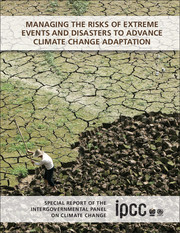 Managing the Risks of Extreme Events and Disasters to Advance Climate Change Adaptation
Managing the Risks of Extreme Events and Disasters to Advance Climate Change Adaptation from Section III
Published online by Cambridge University Press: 05 August 2012
Executive Summary
This chapter assesses how countries are managing current and projected disaster risks, given knowledge of how risks are changing with observations and projections of weather and climate extremes [Table 3–2, 3.3], vulnerability and exposure [4.3], and impacts [4.4]. It focuses on the design of national systems for managing such risks, the roles played by actors involved in the system, and the functions they perform, acknowledging that complementary actions to manage risks are also taken at local and international level as described in Chapters 5 and 7.
National systems are at the core of countries' capacity to meet the challenges of observed and projected trends in exposure, vulnerability, and weather and climate extremes (high agreement, robust evidence). Effective national systems comprise multiple actors from national and sub-national governments, private sector, research bodies, and civil society, including community-based organizations, playing differential but complementary roles to manage risk according to their accepted functions and capacities. These actors work in partnership across temporal, spatial, administrative, and social scales, supported by relevant scientific and traditional knowledge. Specific characteristics of national systems vary between countries and across scales depending on their socio-cultural, political, and administrative environments and development status. [6.2]
The national level plays a key role in governing and managing disaster risks because national government is central to providing risk management-related public goods as it commonly maintains financial and organizational authority in planning and implementing these goods (high agreement, robust evidence). National governments are charged with the provision of public goods such as ensuring the economic and social well-being, safety, and security of their citizens from disasters, including the protection of the poorest and most vulnerable citizens. They also control budgetary allocations as well as creating legislative frameworks to guide actions by other actors.
To save this book to your Kindle, first ensure [email protected] is added to your Approved Personal Document E-mail List under your Personal Document Settings on the Manage Your Content and Devices page of your Amazon account. Then enter the ‘name’ part of your Kindle email address below. Find out more about saving to your Kindle.
Note you can select to save to either the @free.kindle.com or @kindle.com variations. ‘@free.kindle.com’ emails are free but can only be saved to your device when it is connected to wi-fi. ‘@kindle.com’ emails can be delivered even when you are not connected to wi-fi, but note that service fees apply.
Find out more about the Kindle Personal Document Service.
To save content items to your account, please confirm that you agree to abide by our usage policies. If this is the first time you use this feature, you will be asked to authorise Cambridge Core to connect with your account. Find out more about saving content to Dropbox.
To save content items to your account, please confirm that you agree to abide by our usage policies. If this is the first time you use this feature, you will be asked to authorise Cambridge Core to connect with your account. Find out more about saving content to Google Drive.